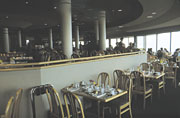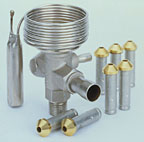

The rules are not cast in concrete. They do not always apply to every system, nor do they work in every circumstance. It is expected that the technician using them is a professional who can use reason and exercise caution in their application.
Rules of thumb usually assume certain normal design and operating criteria, which are not always present.
The rules are not to be used for system design purposes. Rather, they are the result of carefully studying good system designs. Technicians and engineers, however, can benefit from using them as tools for estimating and solving operational problems.
Here are some common hvacr rules of thumb.
AIRFLOW
Air quantities (cfm):These are the approximate amounts of air that should be moving through evaporators for three common applications. Say, for example, you have a comfort cooling application at a savings and loan office that has a 10-ton system. Therefore, you multiply 10 tons by 400 cfm per ton to reveal the total system airflow requirement of 4,000 cfm under normal operating conditions.
This is the average air quantity required for a room or an entire building. This number is based upon an averaged heat load calculation for comfort cooling. There is an assumption of an 8-ft ceiling, no unusual window areas, and average insulation. This rule of thumb provides about 7.5 air changes per hour.
This rule is a quick way to approximate the cooling load for a room or building and may be helpful in estimating room air quantities. For example, to estimate the number of tons required to cool a 1,600-sq-ft home, multiply 1,600 by 1 cfm/sq ft to get 1,600 cfm of air. Using the 400-cfm/ton rule, divide 1,600 cfm by 400 cfm/ton to get 4 tons of required cooling.
This is the average number of times in each hour that the air in the building or room (assuming 7- to 8-ft ceilings) is removed and replaced by circulating the air.
Air velocities (fpm):
These are the recommended air speeds for filters. Speeds higher than these will decrease filtering efficiency.
These are the recommended velocities for coils. Speeds faster than these may cause condensation to be blown off of the evaporator fins and down the duct. Speeds slower than 400 fpm may cause the evaporator to freeze over.
Terminal velocities are the velocities at the end of the run, such as registers or diffusers, where the air enters a room.
This is the average percentage of air that bypasses or fails to come into contact with the evaporator as it passes through the evaporator. The higher the air speed in fpm, the higher the bypass factor. High bypass factors are normally found on heat pumps in the heating cycle, and on high sensible heat applications like computer room systems. Low bypass factors are found on high latent heat applications, such as those found in restaurants (especially cooking areas) and bowling alleys.
BUILDING AIR PRESSURE
Building air pressure is normally between 0.03 to 0.05 in. of static pressure. Infiltration air leaks into a building from the outside, such as through doors and cracks around windows. This infiltrating air is unfiltered and untreated.To prevent infiltration, a building is kept at a slightly positive air pressure. This is accomplished by adjusting the outside air dampers so they are open slightly more than the exhaust air dampers. Building air pressure measurements should be taken whenever an adjustment is made.

REFRIGERATION AND A/C
The valve controls evaporator superheat, which means it controls the amount of liquid refrigerant boiling in the evaporator. The lower the superheat, the more liquid in the evaporator.
However, superheat that is too low can cause the valve to lose control of the superheat altogether. The valve only controls evaporator superheat. If the valve is properly controlling superheat, do not adjust it to change evaporator temperature or pressure. The valve is not an evaporator temperature or pressure control, so do not attempt an adjustment without measuring the superheat. The 8° to 12° superheat is normal for air conditioning systems. Low-temperature systems often use different valves and lower superheat settings.
Remember, superheat is a temperature differential, not a single temperature measurement.
Normal system superheat is 20° to 30°. System superheat is not the same as thermostatic expansion valve superheat. System superheat consists of the temperature differential from the point in the evaporator where all the refrigerant has changed to a gas to the suction line — about 6 in. from the compressor service valve.
Normally, charged and operating systems will have a system superheat of 20° to 30°. System superheat greater than 30° may indicate that the low side of the system is starved for refrigerant. System superheat less than 20° may indicate that the low side is overcharged.
Again, system superheat is a temperature differential, not a single temperature measurement. The valve superheat is part of the system superheat.
Refrigerant in the condenser changes from a gas to a liquid and then begins to subcool. Subcooling takes place in the bottom of the condenser and in the liquid line. The amount of subcooling taking place in the condenser is 5° to 15°. It is never greater than 15°.
Since only liquid subcools, the amount of subcooling is an indication of the amount of liquid in the high side of the system. Overcharged systems have higher-than-normal amounts of subcooling. Undercharged systems have low subcooling.
Comparing high-side subcooling and low-side system superheat will usually solve most refrigeration cycle problems of overcharge, undercharge, and restrictions.
Measuring the temperature drop, or difference of the air as it moves through the evaporator, is one method of approximating correct airflow. Assuming 400 cfm per ton of cooling, when the airflow is correct there will be an 18° to 20° drop in air temperature.
Abnormally low airflow will remain in contact with the evaporator longer, and will be chilled to a lower temperature and greater temperature difference.
Lack of air over the condenser results in high head pressure, lower system capacity, and increased power consumption. Air is heated as it passes through the condenser.
Low air across a condenser is indicated by an air temperature rise greater than 30°. The smaller quantity of air over the condenser must absorb the same amount of heat; therefore, the temperature rise is greater.
WATER
The same is true for a water-cooled condenser. An 8° temperature change is proportional to about 3.9 gpm circulated per ton. A 10° change is proportional to about 2.4 gpm circulated per ton.
For example, if a 25-ton system has a chilled water temperature differential of 8°, then 25 tons times 3.9 gpm/ton gives a total estimate of the chilled water flow of 97.5 gpm.
Christopherson is an hvac instructor at San Jose City College, San Jose, CA.
Publication date: 02/05/2001

Report Abusive Comment